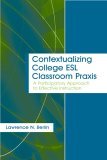
September 2006
Volume 10, Number 2
| Contents | | | TESL-EJ Top |
 |
September 2006
|
||
|
Contextualizing College ESL Classroom Praxis: | |||
| Author: | Lawrence N. Berlin (2005) |  | |
| Publisher: | Mahwah, NJ: Lawrence Erlbaum Associates | ||
| Pages | ISBN | Price | |
|---|---|---|---|
| Pp. xxiii + 133 | 0-8058-4988-2 | $24.50 U.S. | |
Lawrence Berlin's Contextualizing College ESL Classroom Praxis: A Participatory Approach to Effective Instruction is an important contribution to the ongoing discussion on what constitutes effective English as a second language (ESL) teaching practices. The participatory approach he advocates in the ESL classroom is based on Paulo Freire's critical pedagogy principles (1970). However, rather than replicating Freire, his framework synthesizes these principles, multicultural education, and the communicative approach to language teaching. His model language classroom is more than a place in which a transmission model of learning is applied; rather, he believes that the multicultural ESL classroom is a "microcosm of society" (p. 93) in which democracy, multiculturalism, and social justice should be promoted. Therefore, he proposes that a participatory approach would promote such equity through a supportive environment, one in which knowledge and notions of effective instruction are socially co-constructed through interactive dialogues between teachers and students.
Berlin suggests that teachers carry out his participatory approach in the ESL classroom through problem-posing, a central modus operandi of critical pedagogy, in three cyclical stages: naming, reflection, and action (Wink, 1997). According to Berlin, naming materializes "through observation and recognition of a problem through discussions with students" (p. 8). Reflection, on the other hand, "requires the situating of the problem in space and time and in relation to the individual and the larger society" (p. 8). Lastly, "[a]ction provides a means of redressing the problem" (p. 8). Throughout the book, Berlin encourages his readers to take part in this process. Each chapter begins with pre-reading questions (naming); followed by discussing the questions (reflection); and closes with post-reading questions, reflective journal prompts, and follow-up activities (action). He explains that the real action, however, is in bringing a new understanding into classroom practices: "Érecreating education in a way that becomes a truly democratizing force for all those whose lives you touch, bringing about the realization of the action element: social justice" (p. xvi).
The book is cohesively organized into ten chapters as follows:
| Chapters | Contents |
|---|---|
| 1 - 2 | A brief historical overview of second language (L2) pedagogy to establish a contemporary framework for L2 instruction; earlier definitions of effective instruction are problematized to provide a rationale for a new model of effective L2 instruction. |
| 3 | A succinct review of relevant theories and research on L2 acquisition and the various factors affecting the acquisition of an L2. |
| 4 - 5 | Insider perspectives of both teachers and students in one particular academic ESL program on what constitutes effective instruction in the context of multicultural college ESL classrooms. |
| 6 - 8 | Description and analysis of the three components of effective language instruction: pedagogical, environmental, and societal functions. |
| 9 - 10 | Synthesis of the three functions of language instruction to provide a new model of effective instruction, and the model's application to other teaching contexts. |
Berlin recognizes that language teaching is a highly situated activity located in specific contexts, in his case multicultural college ESL classrooms. To be exact, the book is based on his ethnographic study of ESL classrooms in an intensive English program (IEP), just one example of a college ESL context. Therefore, the book could have been more truly representative of "multicultural college ESL classrooms" if other college ESL contexts were included, such as ESL classes for matriculated university students and community college students. Additionally, the student participants in the study seem to represent only those IEP students with a sufficient command of English to voice their opinions about their needs and goals and their ideas of effective language instruction. Those students less capable of expressing their thoughts are not included in this particular dialogue on effective ESL pedagogy. Furthermore, while the voices of both students and teachers are essential in establishing a model for effective ESL instruction, we cannot ignore the fact that college ESL classes, and most ESL classes, are part of a larger structured program with its own agenda and ideology of effective instruction. Therefore, including the program's voice in this dialogue, so as to register all the stakeholders' converging and diverging notions about just what effective ESL instruction is, might have provided a more pragmatic model.
Despite these limitations, the idea of approaching language teaching through a participatory stance is still refreshing and inspiring. Berlin's effective instruction model and participatory framework compel ESL teachers to reflect on and re-examine their perspective on the roles and functions of teachers, students, and the language classroom. From his perspective, the classroom is a dynamic, interactive stage where teachers and students act as co-constructors of knowledge while pursuing education for democracy. ESL teachers will appreciate the structure he provides for promoting multicultural and transformative education, and social justice, in their classrooms-and even beyond them.
Furthermore, this book provides language teacher educators with a valuable supplement to the more traditional texts found in ESL methodology and practicum courses. He wants such trainers also to work collaboratively with their students as full partners to "critically examine and redefine praxis to make it more effective" (p. 117).
Freire, P. (1970). Pedagogy of the oppressed (M. Bergman Ramos, Trans.). New York: Continuum.
Wink, J. (1997). Critical pedagogy: Notes from the real world. White Plains, NY: Longman.
Joseph J. Lee
Georgia State University, Atlanta
<esljolx langate.gsu.edu>
langate.gsu.edu>
|
© Copyright rests with authors. Please cite TESL-EJ appropriately.
Editor's Note: The HTML version contains no page numbers. Please use the PDF version of this article for citations. |